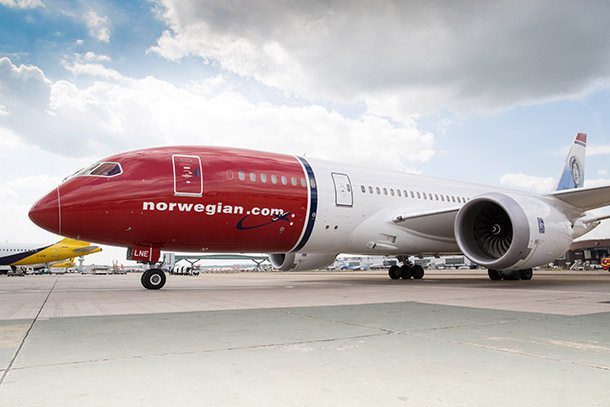
dreamliner787norwegian dd
Norwegian has filed for bankruptcy for four of its crew subsidiaries in Denmark and Sweden, it announced on April 20. The low-cost airline has also canceled crew provision agreements with OSM Aviation for crew based outside Scandinavia. In total, 4.705 cockpit and cabin crew are affected.
Norwegian CEO Jacob Schram quotes the impact of Covid-19 as the reason for the bankruptcies. While crew flying under the Norwegian subsidiary is covered by Norway’s government payroll scheme, those based in Denmark and Sweden are not.
“Despite the measures that the company has already taken, coupled with the lack of significant financial support from the Swedish and Danish governments, we are left with no choice”, Schram says in a statement. Included in the bankruptcy are Norwegian Pilot Services in Sweden and Denmark, Norwegian Cabin Services in Denmark, and Norwegian Air Resources Denmark.
The cancelation of contracts with OSM Aviation affects crew based in the UK, Spain, Sweden, Finland, and the US. OSM had already scaled down operations due to the impact of Covid-19 on the airline industry, including Norwegian.
The announcement affects 1.571 of Norwegian’s pilots and 3.134 cabin crew. Not affected are 700 cockpit crew and 1.300 cabin crew based in Norway, France, and Italy.
“It is heart-breaking that our Swedish and Danish pilot and cabin crew subsidiaries now are forced to file for bankruptcy, and I’m truly sorry for the consequences this will have for our colleagues. We are working around the clock to get through this crisis and to return as a stronger Norwegian with the goal of bringing as many colleagues back in the air as possible,” Jacob Schram said in a statement.
Norwegian’s health questioned before
As demand for air travel dropped, Norwegian lost -61 percent in passenger numbers in March. It reduced capacity by -53 percent.
But it isn’t just Covid-19 that has an impact on Norwegian. Even before the pandemic, the debt-burden airline was seen as one of the weakest financially in Europe. At the end of 2019, it had a net interest-bearing debt of NOK 58.2 billion, up 83 percent from the previous year with just NOK 3.006 billion in cash. Its contractually committed capital expenditures for this year are $1.5 billion, exposing it to major liquidity risks for the purchase of Boeing MAX aircraft of which it expected sixteen this year.
Since early 2019, the focus has been on cost-cutting, return to profitability, and improving cash flow. Under Focus2019, Norwegian targeted NOK 2.3 billion in savings last year of which 1.848 billion was realized by Q3. For 2021, the plan was to improve EBITDAR by NOK 4 billion under the Norwegian Excelling Together (NEXT)-program.
Part of the restructuring was the sale of 24 short-haul aircraft valued at NOK 2.2 billion. While sixteen deliveries were planned, the net short-haul fleet was to be reduced by fifteen with the long-haul to grow by nine.
300 million in state guarantees
Norwegian applied for NOK 3 billion in state aid in March and was granted 300 million of that on March 24 after two Nordic banks obtained credit committee approval, giving the company much-needed if little liquidity. The remaining NOK 2.7 billion is conditional on loans being guaranteed by private sector involvement. It’s this that is the hardest thing for Schram and his team to conclude.
During a virtual meeting on April 30, Norwegian asks support from bondholders for this package which will then be presented on May 4 to shareholders at another virtual extraordinary meeting.
A lot is at stake at Norwegian now that it has parted company with one of its greatest assets so far: the majority of it’s the staff. This indicates a strategy of a much smaller Norwegian that will continue without its long-haul network, analysts from Credit Suisse and others have said in media reports. Today’s announcement is a strong indication that this crisis shouldn’t last much longer, or Norwegian won’t see the end of it.
Views: 6


